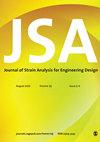旋转纤维增强变厚圆盘的热机械应力分析
IF 1.4
4区 工程技术
Q3 ENGINEERING, MECHANICAL
Journal of Strain Analysis for Engineering Design
Pub Date : 2021-12-02
DOI:10.1177/03093247211060996
引用次数: 1
摘要
采用解析方法对变厚度的周向纤维增强复合材料圆盘进行了建模。磁盘在无牵引条件下旋转,沿磁盘半径的稳态径向温度梯度减小、恒定和增加。采用Tsai-Wu和Norris失效指标计算了极限角速度。随后,这些极限速度逐渐降低,以检查应力场和位移场。所得结果表明,随着角速度的减小,温度梯度的影响更加明显。在较低的角速度下,这些梯度甚至可能改变应力场方向。此外,不同失效准则的实施可能会在相当程度上改变计算的极限速度。因此,应注意选择失效指标,以获得保守的结果。在研究中,还研究了圆盘几何形状对定向应力的影响。不必多说,可以表示几何形状引起应力和位移的轻微变化。本文章由计算机程序翻译,如有差异,请以英文原文为准。
Thermo-mechanical stress analysis of rotating fiber reinforced variable thickness disk
Circumferentially fiber reinforced composite disk, which has a variable thickness, is modeled via analytical approaches. The disk is subjected to rotation in traction free conditions and decreasing, constant, and increasing steady state radial temperature gradients along the disk radius. Limit angular velocities are calculated by operating Tsai-Wu and Norris failure indexes to the problem. Subsequently, these limit velocities are gradually decreased to examine the stress and displacement fields. Acquired results show that as the angular velocity drops, the effects of temperature gradients become more visible. At lower angular velocities, these gradients may even alter the stress field directions. Also, different failure criteria implementation may change the calculated limit velocities to a considerable degree. Therefore, the failure index should be chosen attentively to procure conservative results. In the investigation, the influence of disk geometry on the directional stresses is studied as well. Without further ado, it can be expressed that the geometry causes slight alterations in stresses and displacements.
求助全文
通过发布文献求助,成功后即可免费获取论文全文。
去求助
来源期刊

Journal of Strain Analysis for Engineering Design
工程技术-材料科学:表征与测试
CiteScore
3.50
自引率
6.20%
发文量
25
审稿时长
>12 weeks
期刊介绍:
The Journal of Strain Analysis for Engineering Design provides a forum for work relating to the measurement and analysis of strain that is appropriate to engineering design and practice.
"Since launching in 1965, The Journal of Strain Analysis has been a collegiate effort, dedicated to providing exemplary service to our authors. We welcome contributions related to analytical, experimental, and numerical techniques for the analysis and/or measurement of stress and/or strain, or studies of relevant material properties and failure modes. Our international Editorial Board contains experts in all of these fields and is keen to encourage papers on novel techniques and innovative applications." Professor Eann Patterson - University of Liverpool, UK
This journal is a member of the Committee on Publication Ethics (COPE).
 求助内容:
求助内容: 应助结果提醒方式:
应助结果提醒方式:


